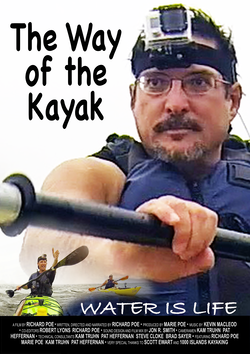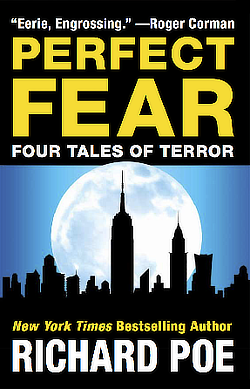PERFECT FEAR: EPILOGUE
My Promise to St. Jude
by Richard Poe
Excerpted from Perfect Fear (released by Heraklid Books, July 5, 2012)
IN THE YEAR 1873, a nine-year-old boy fell ill. His arms, legs and face swelled up and he lay unconscious for twelve days. Everyone thought he would die. But he didn’t. After twelve days, the boy woke up. He seemed perfectly all right. At least on the surface.
His name was Black Elk. He was a young warrior of the Oglala Lakota. Like all boys of his tribe, Black Elk was raised to be rough and tough. He could ride horses and hunt game when he was nine years old. He fought in the Battle of the Little Bighorn at the age of 12. But a strange thing happened to him when he was 16 years old. Black Elk suddenly lost his courage. He became afraid.
He heard voices everywhere. Animals spoke to him. Thunderclouds called to him. Black Elk later told his biographer, “I was afraid to see a cloud coming up… I was afraid of the stillness when everyone was sleeping… Sometimes the crying of coyotes out in the cold made me so afraid that I would run out of one tepee into another, and I would do this until I was worn out and fell asleep.”2 Black Elk was consumed with fear. He lived that way for many months, until he was 17 years old.
Nowadays, a young man in Black Elk’s condition would probably end up in a psychiatrist’s office, and he might be treated with antipsychotic drugs. But the Lakota people did not have psychiatry in those days, so Black Elk’s parents took him to a medicine man. Under the old man’s questioning, Black Elk finally broke down and told the truth.
Black Elk’s Confession
The truth was that Black Elk had seen a vision. It happened during that mysterious illness when he was nine years old. In his vision, he was swept up into the clouds, where he met the six Grandfathers or powers of the earth. They showed him the past, present and future of his people. They showed him two paths, the red path of life and the black path of death. Then they sent him back to earth. Black Elk never told anyone what he had seen. He feared that people might think he was crazy. And so he kept silent about his vision.
“Ah!” said the holy man, after hearing Black Elk’s story. Now he understood. He told Black Elk that he was suffering because he had kept his vision to himself. This message was meant for the whole people. Black Elk needed to tell everyone what he saw. “Then the fear will leave you,” said the holy man. “But if you do not do this, something very bad will happen to you.” Black Elk obeyed. He told his vision to the people. The whole village reenacted his vision in a ritual dance. And afterwards, many who were sick became well. Gladness filled everyone’s heart. Black Elk later said, “Even the horses seemed to be healthier and happier after the dance.”
The story of Black Elk is true. I first read about it in college, in a book on Jungian psychology called Man and His Symbols.3 The story taught me that, if you have a vision, you must share it with others. You must not keep it to yourself. Unfortunately, I failed to apply that lesson in my own life. Nine years ago, in 2003, something very important happened to me. I knew that I was supposed to share that experience with others, but I didn’t. Like Black Elk, I suffered for it. I would like to break my silence now. I will tell you about a prayer I made to St. Jude, nine years ago. This book, Perfect Fear, is an answer to that prayer.
Uncle Johnny and the Virgin Mary
One day, in the summer of 2003, I was sitting at the dinner table with my wife Marie and my mother, who was then staying with us. Somehow the talk came around to Marie’s Uncle Johnny. Marie told us the story of how her uncle escaped death, by calling out to the Virgin Mary.
He was working as a construction inspector on a New York City bridge. One day, he climbed up a forty-foot ladder to inspect the paint. Unfortunately, someone forgot to screw the ladder in place, and it tipped over. The ladder fell straight backwards, with Uncle Johnny clinging to it. Had he fallen on his back, he would have died. But, as he fell, he cried out in Greek. He shouted, “Panagia ti Giatrissa (pah-nah-YEE-ah tee YAH-tree-sah)!” As he shouted these words, the ladder swiveled to one side. That slight movement of the ladder saved Uncle Johnny’s life. He hit the pavement on his side, rather than his back. He broke an arm and a leg, but he was otherwise unhurt.
While he was falling, Uncle Johnny had called out to the Virgin Mary. He called her Panagia (pah-nah-YEE-ah), which is the Greek name for the Virgin Mary, and also Giatrissa (YAH-tree-sah), which means healer. Panagia ti Giatrissa or Panagia the Healer is the name of a miraculous icon, which is kept in a monastery, deep in the mountains of southern Greece, in a place called Mani. It happens that Uncle Johnny’s family came from Mani. People in those parts have a deep devotion to this particular icon. They believe the icon has power to heal the sick. And so, when Uncle Johnny’s ladder tipped over, he called out to Panagia the Healer. To this day, his whole family believes that the
icon saved his life.
My Mother Responds
Upon hearing Marie’s story, my mother decided to tell a tale of her own. She told us about a man she once knew, who was diagnosed with bone cancer. At the time, my mother was a young medical technician, working in a hospital. She understood that her friend faced a long and agonizing death. Being a good Catholic, she advised him to pray to St. Jude.
St. Jude is the patron saint of lost causes, the help of the hopeless. You pray to him when there is nowhere else to turn. My mother’s friend had never heard of St. Jude. Being Protestant, he had never prayed to any saint. But he trusted my mother, and followed her advice. He made a novena to St. Jude. A novena is a special prayer which you repeat every day for nine days. About two weeks after completing his novena, the man died. His death came suddenly, for no particular reason. The doctors were mystified. They had expected him to live many months, while the cancer spread. My mother concluded that St. Jude had taken this man’s life, in order to spare him the agony of a slow death from bone cancer.
As we pondered this grim yarn, my mother went on to tell us a somewhat happier tale. She told us the story of Danny Thomas, the popular TV star of the 1950s. As a struggling young nightclub comedian, Danny Thomas found himself at a crossroads in life. His wife was pregnant, and his career was going nowhere. Thomas wondered if it was time to get a regular job and give up on show business. He went to church, knelt down before a statue of St. Jude and begged for help. Shortly afterwards, his luck turned. He started getting breaks in the entertainment business. Eventually, he got his own hit show on TV. In gratitude to the saint, Thomas later founded St. Jude Children’s Research Hospital.
The Power of the Saints
As my mother spoke that evening, I could hardly believe my ears. It had been many years since I last heard her speak about her Catholic faith. I had thought she no longer believed in it.
My mother stopped attending church when we were still children. She did not like the changes that rocked the Church during the 1960s: the phasing out of the Latin mass; the introduction of “folk masses” replete with guitars, tambourines and Bob Dylan ballads; the hip young priests quoting “Jesus Christ Superstar” lyrics from the pulpit. As the years went by, my mother became ever more critical of the Church, and disillusioned with organized religion in general. As far as I could tell, she had rejected her Catholic beliefs completely. Yet here she was sitting at my dinner table, telling stories of the saints. Moreover, it was clear that she believed those stories to be true.
In that moment, I learned something about the Catholic faith which I had not understood before. I learned about the power of the saints. The saints work through stories. They reach us through simple tales that we tell each other over the dinner table, sometimes for no other reason than sheer entertainment, just to make small talk or pass the time. And yet those stories have the power to change lives. My mother’s stories about St. Jude took root in my mind. I could not stop thinking about them. Going on the Internet, I looked up everything I could find about Danny Thomas and his pledge to St. Jude. And, slowly, I formed a resolve that I too would make such a pledge.
“Show me my way”
Of course, I was in a very different position than Danny Thomas had been. When he made his petition to St. Jude, Thomas was a young man of 25, just starting out in life. In 2003, I was already 44 years old, a successful author with many bestselling books. Yet something was wrong. All my life, I had struggled to make my voice heard. But I no longer knew what I wanted to say.
Breaking into the book business had taken many years of hard work and sacrifice. When the payoff finally came, and my first bestsellers began yielding five and six-figure royalty checks, I thought my struggles were over. Henceforth, I imagined, I would live the life of a gentleman author, earning a fulltime living from writing books. And, for a good seven years, that’s just what I did.
My wife and I grew accustomed to spending our summers in the Hamptons or the Greek islands. We were living the good life. We thought it would never end. But success is fleeting, especially in the media business. You’re only as good as your last hit. By 2003, I was beginning to worry about my future. And so, when I sat at my dinner table, hearing my mother’s stories about St. Jude, I found myself listening with unusual keenness.
On July 5, 2003, I entered a Catholic church in my neighborhood, knelt down before the statue of St. Jude and promised the saint that I would return to the faith. I prayed, using the same words as Danny Thomas: “Show me my way in life.” In keeping with my vow, I returned to the Church and received my long-overdue Confirmation. I began attending Mass each week, and prayed the Rosary every day. But one promise I left unfulfilled.
My Broken Promise
When you petition St. Jude for help, you are supposed to “publish” the results of your petition. In other words, you are supposed to tell people how St. Jude helped you. You must not keep it to yourself. Most people share their stories by word of mouth, among friends and family. Some post their stories on the Internet.
But, as a bestselling author, I realized that I had a heavier obligation than most. Jesus said, “Unto whomsoever much is given, much shall be required.” (Luke 12:48). As a many-times published author, I knew that I had better resources than most for spreading the word about St. Jude. But I had not used those resources to their fullest.
Of course, I had a good excuse. At least, it seemed like a good excuse. St. Jude had not yet answered my prayer. He had not yet shown me my way in life. How could I tell my story, when I didn’t know the ending yet? This seemed like a perfectly reasonable question. Many times I put this question to the statue of St. Jude standing in the back of my church. Each time, the statue stared back at me with its eyes of painted wood, and said nothing.
And so things continued for nine years. It was easy to imagine that St. Jude had abandoned me. But he had not. He was already hard at work, answering my prayer. I just didn’t know it yet. I had prayed for a new path, and a new path awaited me. But I was not yet ready to walk it. Before St. Jude could open a new door for me, he had to close all the old ones first.
Acting on Faith
I once read a book about a man who was imprisoned for burglary when he was 20 years old. He was a gambler, robber, drug dealer and pimp. He seemed to be headed for a life of crime.
But one day in prison, the young convict received a letter from his brother. It said, “Don’t eat any more pork, and don’t smoke any more cigarettes. I know how to get you out of prison.”
The letter did not explain how these simple acts could get anyone out of prison. But the young convict trusted his brother and acted on faith. He stopped smoking and stopped eating pork. And very soon his life changed. After serving only two years of his eight-year sentence, he was released on parole. He became known as a community leader, a man of God, and finally as a hero of his people, a champion of freedom and human rights for African Americans. His name was Malcolm Little. History will always remember him as Malcolm X.
When Little first resolved to stop eating pork in prison, he had no idea where this act would lead him. He never guessed that he was taking the first step on a spiritual journey, a path which would eventually lead him to embrace the religion of Islam. He had no way of foreseeing this. He simply acted on faith. In so doing, he found his destiny.
Likewise, when my mother told me those stories about St. Jude over the dinner table, I had no way of knowing what would come of it. I could not see what lay ahead.
Consecrated to the Blessed Virgin
Jesus said, “If you have faith as small as a mustard seed, you can say to this mountain, ‘Move from here to there’ and it will move. Nothing will be impossible for you.” (Matthew 17:20) When my mother told us those stories about St. Jude, her faith in the Catholic Church was probably just about as small as a mustard seed, maybe smaller. Yet it was strong enough to move mountains. It was strong enough to move me.
Nine years have passed since I made my pledge to St. Jude. My faith is still small, like a mustard seed. But it was just large enough to enable me to take a chance, just large enough to encourage me to write this book, Perfect Fear.
This is my first published work of fiction. All my previous books were non-fiction. When I set out to write Perfect Fear, I had no idea if it would work. I only knew that it was my lifelong dream to write fiction, and it was time to put that dream to the test. And so I consecrated the work to the Blessed Virgin Mary, and asked her to inspire me.
Some might find that a strange prayer. Why should I hope or expect that a saint so pure as the Virgin Mary would extend her blessing over a work so dark as a collection of horror tales? Quite frankly, I had no idea why she would. But I had just enough faith to ask.
While I worked on this book, I prayed to the Blessed Mother night and day, seeking her guidance and protection. I asked her to shape this book and guard it from evil influences. I prayed that, if the work displeased her, she would stop me from writing it. But she did not stop me. No one can say if the Blessed Mother inspired or even remotely approves of Perfect Fear. I only know that she allowed me to finish it. I have just enough faith to hope that this book enjoys her blessing and favor, just the tiniest grain of hope, as small as a mustard seed. And maybe that is enough.
RICHARD POE
New York City
__________________________________
2 John G. Neihardt, Black Elk Speaks: Being the Life of a Holy Man of the Oglala Sioux (Albany, New York: Excelsior Editions / State University of New York Press, 2008 edition, pp. 125-126; originally published 1931)
3 Marie-Louise von Franz, “The Process of Individuation,” in Carl Gustav Jung, et. al., Man and his Symbols (Garden City, New York: Doubleday & Company Inc., 1964), 228
Excerpted from Perfect Fear (released by Heraklid Books, July 5, 2012)








